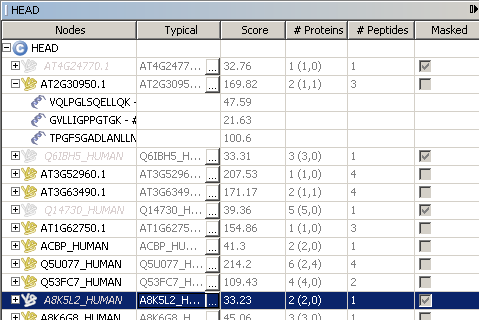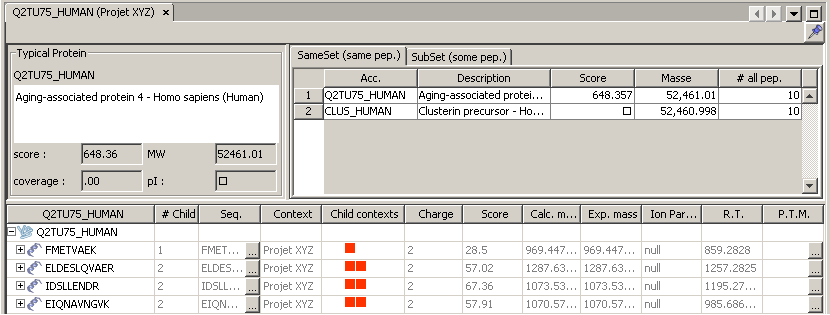This is an old revision of the document!
Table of Contents
Protein Groups
Definition
A Protein Group (similar to Mascot® protein hit) is a collection of proteins identified by a set of peptides. A Protein Group contains not only all proteins covered by the same set of peptides but also all proteins covered by a subset of these peptides. In details, a Protein Group:
- is represented by a master (or typical) protein
- contains a collection of peptides identifying this master protein
- contains a collection of proteins having the sameset of peptides
- contains a collection of proteins having a subset of peptides
A Protein Group is always attached to a Context, Search or User Context. For the latter, protein groups are obtained when running the Protein Grouping algorithm on a given context.
Browsing protein groups
Protein groups are associated to a context, thus it is possible to browse protein groups for a specific context.
 This window list all protein groups by their typical protein accession (represented by
This window list all protein groups by their typical protein accession (represented by  ). At least, the number of peptides and the typical protein score is specified. if other properties are associated to the protein group or typical protein, such as spectral count, they could also be displayed (
). At least, the number of peptides and the typical protein score is specified. if other properties are associated to the protein group or typical protein, such as spectral count, they could also be displayed ( see property page)
see property page)
For each group a list of all peptides used to identify the proteins is also displayed.
View protein group details
hEIDI allow users to access protein group's detail from different place.
The protein group window shows
- details about this typical protein
- lists of group content: sameset/subset proteins and peptides
If you select another protein from the sameset/subset tabs, the table showing peptides will be updated accordingly. Only peptide matching the selected protein will be displayed.
Details about the “Child contexts” column in the treeview:
Peptides and their childs (= new peptides obtained when protein grouping is executed on a given context) are displayed recursively in the treeview.
For each “parent” peptide node, the image in the “Childs” column displays, as small coloured squares, the context(s) of the child peptide(s).
A different colour is used according the depth of the context.
When positioning the mouse cursor onto the image, the context names are displayed as a tooltip.
The context of the last child peptide is not represented (a context is actually an identification result in this case).


